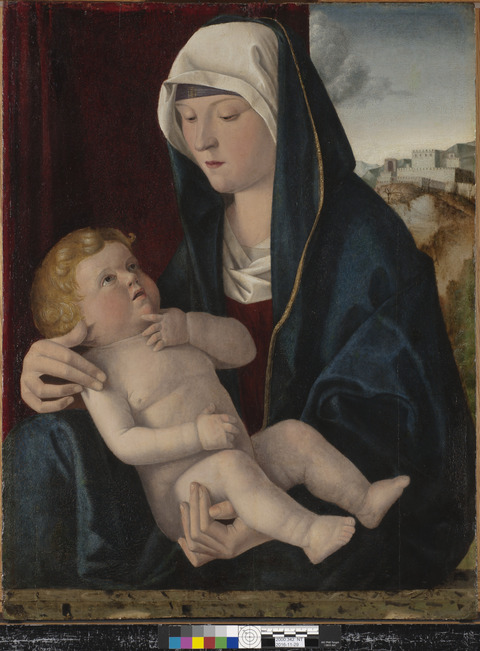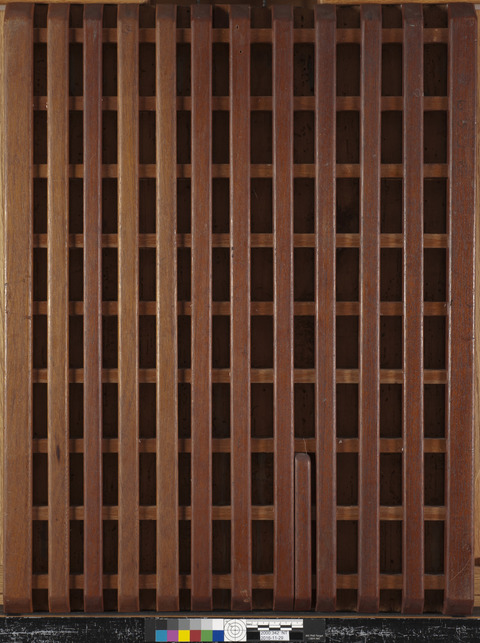Overview
Accession number: 2000.342
Artist: Workshop of Giovanni Bellini
Title: Madonna and Child
Materials: Egg tempera and oil [confirmed] on poplar panel
Date of creation: About 1510–1515
Previous number/accession number: C10005
Dimensions: 54.6 × 41.9 cm
Conservator/examiner: Fiona Beckett with contributions from Roxane Sperber
Examination completed: 2016, revised 2018
Distinguishing Marks
Front:
None
Back:
None
Summary of Treatment History
Physical evidence suggests the painting underwent several treatment campaigns prior to its arrival at the IMA. The support has been thinned and cradled, and there is a considerable amount of retouching on the surface from previous interventions.
Documentation suggests a series of condition assessments and treatments were carried out on the collection around the time the works were moved from the Clowes residence to the IMA in 1971. A condition report by Paul Spheeris in October of that year, likely carried out before the paintings were relocated, described the painting as having a “small abrasion below baby’s buttocks."1 A second condition assessment was carried out upon arrival of the painting at the IMA. This assessment describes the work as being in stable condition, and no work was deemed necessary. An X-radiograph of the painting was made at this time.2
In 1974, a condition assessment, treatment, and investigation of the collection was carried out by the Intermuseum Conservation Association at Oberlin College. This document describes this painting as having a discolored natural resin varnish with uneven gloss and surface grime. No treatment was recommended but it suggested that removing the surface coating and overpaint would improve the appearance.3 A memorandum explaining the charges for this work indicate it was indeed carried out.4
The painting was inspected in the Clowes Collection annual survey from 2011 to 2018.
Current Condition Summary
Structurally, the painting is in good condition. Aesthetically the painting is in good condition, but it is evident that it has suffered numerous damages in the past. As an example, in the upper left of the painting, the red drapery has been severely abraded and covered with copious amounts of glazed retouching to reduce the appearance of the damage.
Methods of Examination, Imaging, and Analysis
| Examination/Imaging | Analysis (no sample required) | Analysis (sample required) |
|---|---|---|
| Unaided eye | Dendrochronology | Microchemical analysis |
| Optical microscopy | Wood identification | Fiber ID |
| Incident light | Microchemical analysis | Cross-section sampling |
| Raking light | Thread count analysis | Dispersed pigment sample |
| Reflected/specular light | X-ray fluorescence spectroscopy (XRF) | Fourier-transform infrared spectroscopy (FTIR) |
| Transmitted light | Macro X-ray fluorescence scanning (MA-XRF) | Raman microspectroscopy |
| Ultraviolet-induced visible fluorescence (UV) | ||
| Infrared reflectography (IRR) | Gas chromatography–mass spectrometry (GC-MS) | |
| Infrared transmittography (IRT) | Scanning electron microscope -energy dispersive X-ray spectroscopy (SEM-EDS) | |
| Infrared luminescence | Other: high performance liquid chromatography (HPLC); UV microspectrofluorometric analysis, X-ray powder diffraction (XRD), False Color Infrared (FCIR) | |
| X-radiography |
Technical Examination
Description of Support
Analyzed Observed
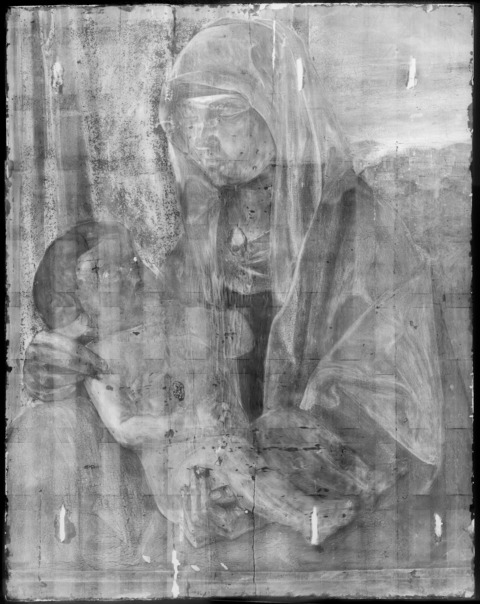
Material (fabric, wood, metal, dendrochronology results, fiber ID information, etc.):
The painting is executed on wood panel with a vertically oriented grain (tech. fig. 1). The wood panel was identified as poplar (Populus spp.) by Peter Klein in 1999.5 The rings along the bottom edge suggest that the panel is a slightly tangential cut. A thin layer of canvas is potentially present over the surface of the painting. It is not easily distinguishable, but a fine thread weave is present in several areas on the X-radiograph. The fabric may have only been applied selectively to cover deformities or knots in the wood prior to the application of the preparatory layers.
Characteristics of Construction / Fabrication (cusping, beveled edges of panels, seams, joins, battens):
The painting was constructed from a single wooden panel with the grain running in the vertical orientation. The panel likely experienced some warping, as evidenced by the cradle and the splits in the support.
Thickness (for panels or boards):
~6 cm, including the attached frame (varies slightly depending on location)
Production/Dealer’s Marks:
None
Auxiliary Support:
Original Not original Not able to discern None
The auxiliary support is not original to the painting. It consists of a full cradle with twelve vertical fixed members and nine horizontal movable members. The panel was thinned prior to the application of the cradle, as was common practice. Marks on the back between the cradle members show evidence of the tools used to thin the panel, such as gouges. Of the moveable members, the fourth and ninth members have seized. A supportive wood patch is placed along the top edge between cradle members six and seven to help support a small split in the original panel.
Condition of Support
The support is in stable condition, although several nicks and dents exist from general wear. There are seven gouges, visible in the X-radiograph, that appear to exist in the support. These are filled with a dense material and look white in the X-radiograph. All seven line up with vertical cradle members and are possibly related to the thinning of the panel prior to the addition of the cradle. It is also possible that they relate to a previous support system, such as two horizontal battens (one upper and one lower) that would have been later removed to allow the cradle to be attached. There appears to be an oval-shaped wood anomaly (approximately 2.5 cm in length) located at the bottom right of the painting. An additional oval wood anomaly (approximately 2.5 cm) is located just below the Madonna figure’s neck and is possibly a knot. While difficult to confirm with certainty, it appears that canvas patches may have been added to these irregularities in the panel. Several splits are present in the wooden panel. Wax resin has been applied to the back in most of the splits (six areas). The splits are very visible in raking light (tech. fig. 2). Some insect flight holes are visible on the front of the painting and appear as slight depressions, for example, in the area of the Madonna’s face.
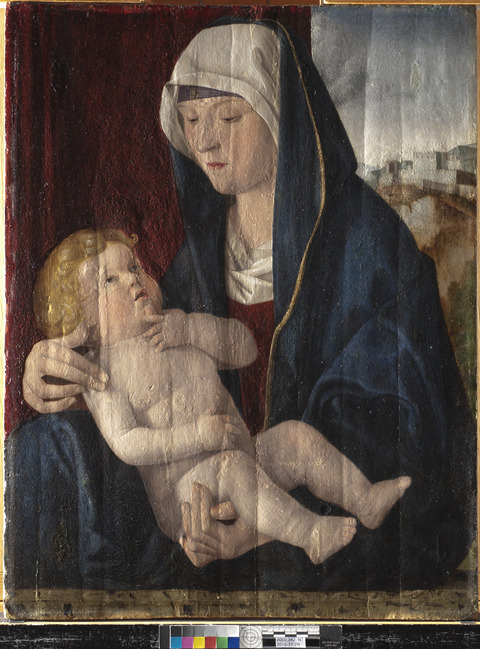
Description of Ground
Analyzed Observed
The ground layer on the painting can be observed in the cracks of the painting (tech. fig. 3). A 2004 study of the Bellini paintings in the IMA collection by Antonietta Gallone and Cinzia Mancuso used XRD to identify the composition of the ground as gypsum.6 This finding is consistent with Italian panel preparation techniques of this period. The ground on the Madonna and Child panel was applied in a single layer.7 This application differs from the application of the ground on Bellini and Workshop’s Madonna and Child with St. John the Baptist (2000.341), also in the Clowes Collection, where the ground has been applied in two distinct layers.
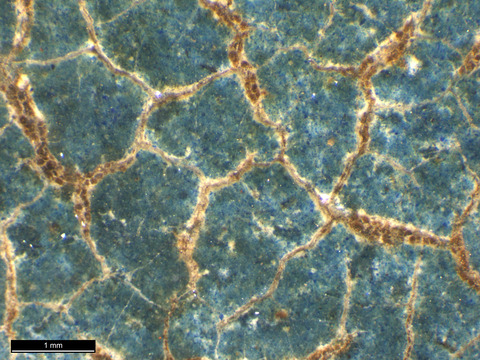
Materials/Binding Medium:
The ground is likely bound with glue (untested).
Color:
The ground color is white.
Application:
Likely brush applied and possibly sanded smooth
Thickness:
The painting has a thick application of ground.
Sizing:
The panel has a layer of animal-glue size.8 This was applied prior to the application of the canvas layer, as well as to assist in adhering the canvas to the underlying wooden support.
Character and Appearance (Does texture of support remain detectable / prominent?):
The texture of the panel is visible through the paint layer in some areas, particularly where the cracks and splits are located.
Condition of Ground
Losses are present around the edges as well as in the composition. Previous fills are visible. Wax fills were applied to the panel and can be seen along the bottom of the left edge. Additional glue-based fills are also present. An elongated craquelure network is present in the ground layer, likely caused by stresses originating in the panel. Near the top edge, just above the Madonna’s head, there appears to be a radiating crack.
Description of Composition Planning
Methods of Analysis:
Surface observation (unaided or with magnification)
Infrared reflectography (IRR)
X-radiography9
Analysis Parameters:
| X-radiography equipment | GE Inspection Technologies Type: ERESCO 200MFR 3.1, Tube S/N: MIR 201E 58-2812, EN 12543: 1.0mm, Filter: 0.8mm Be + 2mm Al |
|---|---|
| mA: | 3 |
| Exposure time (s) | 120 |
| Distance from X-ray tube: | 36” |
| IRR equipment and wavelength | Opus Instruments Osiris A1 infrared camera with InGaAs array detector operating at a wavelength of 0.9-1.7µm |
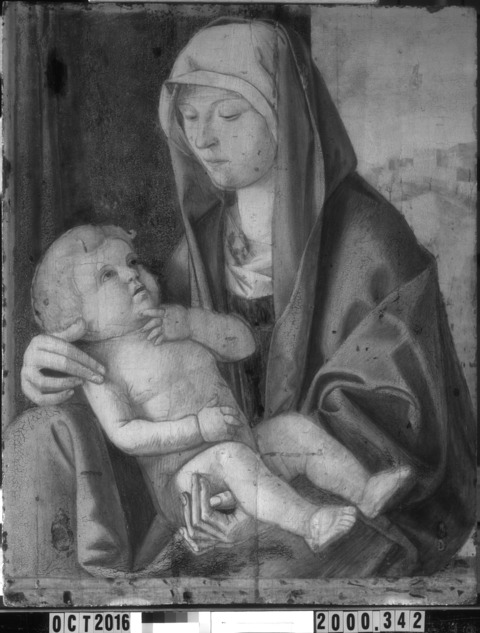
Medium/Technique:
Devotional images of the Madonna and Child were very common, and many similar compositions exist by various artists. The composition of the painting was planned via incised lines that are readily visible in many areas of the painting, including the Madonna’s robes and around the Christ child figure. Most likely a cartoon would have been traced to lay down the initial composition. This method of transfer is referred to as calcare, and while destructive to the cartoon, it is less time intensive than the transfer technique of poking holes in the cartoon (referred to as spolveri).10 At times, the incised lines are obscured by a thicker paint layer. In addition to the incised lines, underdrawing composed of a fluid drawing medium (likely carbon-based) can be seen throughout the painting in the infrared reflectogram (tech. figs. 4, 5). The underdrawing outlines the figures and drapery, with minor adjustments and reinforcements done in a looser hand but still following the general composition as determined by the initial incised lines. Crosshatching is also present and clearly visible in the infrared reflectogram, as well as to some extent the naked eye (tech. fig. 6).
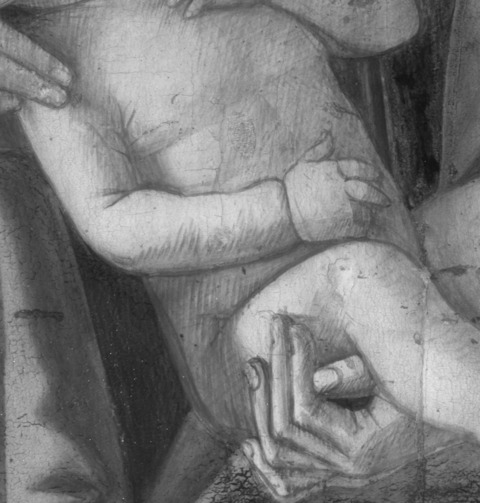
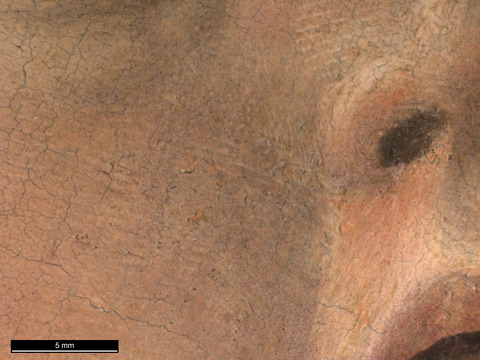
Jill Dunkerton argues that artists linked with Padua often used more extensive underdrawings than their Florentine counterparts. The extensive diagonal hatching visible on this work, and others attributed to Bellini, may have been influenced by contact with Northern Renaissance painters. She further suggests that this contact may be associated with the adoption of oil painting in Italy, as most works that exhibit extensive underdrawing also use an oil medium.11
Pentimenti:
Minor adjustments and reinforcements are present in the figures. Some examples include the Madonna’s chin, which was slightly refined; the contours of her finger on her proper left hand, which were further defined; and the outlines of the Christ child, which were corrected.
Description of Paint
Analyzed Observed
Application and Technique:
The paint was applied using small and medium-sized brushes. Additionally, areas of shadow on the Christ child were tamped in by hand using fingers, and possibly a palm, to gently distribute slightly darker skin tones to the shadows (tech. fig. 7). Fingerprints are readily discernible in the paint film. The paint appears to have been applied using a wet-in-wet technique. Rich brushwork is visible in the figure of the Christ child, and the skin tones are the most well-preserved. Some adjustments were made in the application of the paint layer, including in the outline of the Christ child, where the colored contours for his skin are applied over the blue of the Madonna’s cloak (see tech. fig. 8). The order of overlapping edges of paint suggests the figures were painted, or at least finalized, after the rest of the composition was established. Traction crackle is seen on the blue of the Madonna’s robe, the sky, and the curtains (though partially hidden by the application of glazing layers). This suggests that the paint may have been applied in a lean-over-fat method, accounting for the stress-induced cracking in these areas.
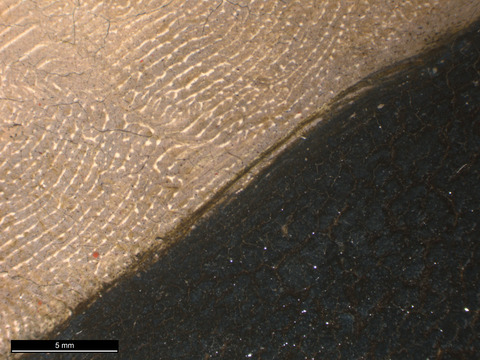

Painting Tools:
Small brushes, fingertips, and palms
Binding Media:
Analysis of binding media by Gallone and Mancuso was carried out on selected cross sections using ultraviolet microspectrofluorometric analysis in preparation for the 2004 publication. This research identified both egg and oil binders.12
Color Palette:
The color palette is relatively simple, with blue, red, and tones for the skin being the main ones present in the painting. A few yellows are present in the Christ child’s hair and in details in the robe and background. Greens, browns, and grays are also present in the background and along the ledge at the bottom of the painting. During their study, cross-section analysis was carried out by Gallone and Mancuso to look at selected areas of the painting. This study identified a palette containing lead white, lead-tin yellow type II, yellow ochre, ultramarine, azurite, red lake, cinnabar, red ochre, copper resinate, brown earths, and charcoal black. In 2016, XRF analysis was conducted in several areas of the painting to gain a broader understanding of the pigments used (see tech. fig. 12). These findings corroborated those found by Gallone and Mancuso.
There are at least two blue pigments used in the painting, ultramarine and azurite, with the possibility that some amount of smalt was used in the sky (sample 9). Several locations in the sky that were suspected of containing smalt were analyzed using XRF to confirm the findings from sample 9. A trace of cobalt and nickel were identified in all locations, but no significant peak for either element was identified.
A small peak for copper was identified in the robe of the Madonna (sample 4). This, in combination with the cross-section analysis by Gallone and Mancuso (tech. fig. 9), suggests that the Madonna’s mantle was painted using an underlayer of lead white with the addition of a small amount of azurite and iron oxide (earth pigments), and the upper layer of paint contained ultramarine (not detectable using XRF analysis).13 In contrast to the analysis on the Madonna and Child with St. John the Baptist (2000.341), which suggests that ultramarine was the primary pigment used in the robe of the Madonna and the sky, on Madonna and Child azurite was used for the underlayer of the blue robe while ultramarine appears to have been used in the upper layer alone. The use of azurite under ultramarine was frequently employed by Italian Renaissance artists, including Bellini, as a cost-saving measure.14
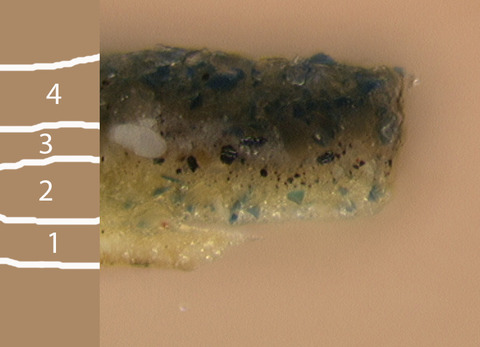
The bluish-purple headband of the Madonna yielded a strong signal for copper, suggesting the blue tones in this area are likely azurite. A trace of mercury was identified as well, suggesting the purple was achieved by mixing the azurite with vermilion and possibly some red lake pigment, which cannot be identified using XRF. In the sky, copper was identified as well as traces of cobalt and nickel, suggesting a small amount of smalt may have been incorporated into this mixture. The discoloration of smalt may, in part, account for the gray appearance of this passage.15 Although not detectable using XRF, several particles of ultramarine were also identified in the sky in the analysis by Gallone and Mancuso.
The greens in the painting, found primarily in the background, include copper-containing pigments. Though not discernible using XRF, cross-section analysis identified the presence of both copper resinate and a mixture of azurite with lead-tin yellow in green passages of the painting.16
Mercury was identified in several spectra from red passages of paint, most prominently in the lips of the Madonna (sample 8), suggesting the presence of vermilion in this area. Traces of mercury were also identified in the flesh tones of the Christ child and the bodice of the Madonna (samples 1, 3).
The curtain is painted with a bright red underlayer followed by a dark red glaze layer (tech. fig. 10). No mercury was identified in either the underlayer or the glaze layer (samples 12, 13). Although not able to be confirmed using XRF, the absence of mercury in the curtain strongly suggests the use of red lake pigments (possibly with a potassium or calcium mordant). A cross section from this area, analyzed by Gallone and Mancuso, found it to be composed of two layers of red lake pigments (tech. fig. 11, layers 2, 4) with an organic isolating layer in between the two layers.17 Analysis by Gallone and Mancuso identified the red lake pigment as cochineal using HPLC.18
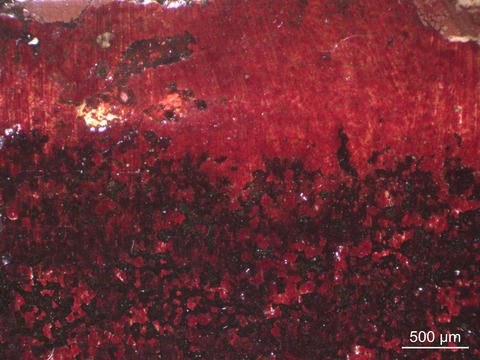
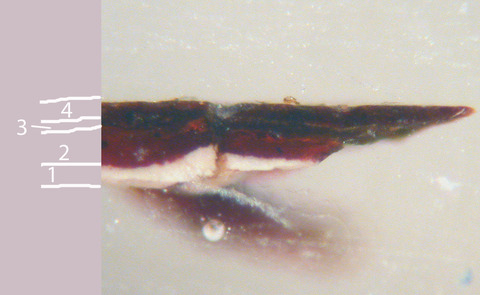
The presence of iron and tin in areas of yellow suggests the use of yellow ochre and lead-tin yellow. Lead white was used throughout the painting, and a strong peak for lead is present in every XRF spectrum. The full results are listed in table 1.
XRF Analysis:
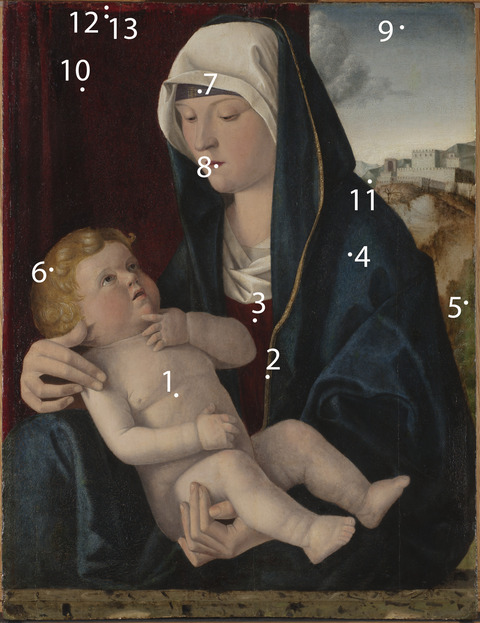
| Sample | Location | Elements | Possible Pigments |
|---|---|---|---|
| 1 | Flesh of Christ child, stomach area | Major: Pb Minor: Trace: Hg, Ca, Fe, Cu | Lead white, traces of vermilion, traces of calcium (likely from ground layer) traces of iron oxide (earth pigments), traces of copper-containing blue or green pigment (likely azurite). |
| 2 | Yellow in the trim of Madonna’s blue veil (above Christ child’s knee) | Major: Pb Minor: Zn, Fe, Trace: Ca, Cu, Hg, Sn | Lead white, zinc white (likely from retouching) iron oxide (earth pigments/yellow ochre), calcium (likely from ground layer), traces of copper-containing pigment (likely azurite), trace of lead-tin yellow, trace of vermilion. |
| 3 | Dark red in Madonna’s clothing (above Christ child’s elbow) | Major: Pb Minor: Fe, Cu, Hg, Ca, K Trace: Mn, Ti | Lead white, copper-containing pigment (likely azurite), possible red lake pigment with potassium or calcium mordant, iron oxide (earth pigments), vermilion, calcium (likely from ground layer). |
| 4 | Blue in robe, proper left shoulder | Major: Pb Minor: Ca, Fe Trace: K, Cu, Ti, Si, Mn, Zn | Lead white, iron oxide (earth pigments), possible dye-based pigment with potassium or calcium mordant, calcium (likely from ground layer), trace of copper-containing pigment (likely azurite). |
| 5 | Green foliage background, right side | Major: Pb, Cu Minor: Trace: Fe, Sn, Ca, Ni, K | Lead white, copper-containing green pigment (likely copper resinate), iron oxide (earth pigments), trace of lead-tin yellow, calcium (likely from ground layer). |
| 6 | Yellow in Christ child’s hair | Major: Pb Minor: Fe, Trace: Ca, Hg, Cu, Zn, Sn, Ti, Mn, K | Lead white, iron oxide (earth pigments likely including yellow ochre), calcium (likely from ground layer), traces of vermilion, traces of copper-containing green and/or blue pigment, trace of lead-tin yellow, trace of zinc (likely from retouching). |
| 7 | Dark blue-purple in Madonna’s headpiece | Major: Pb, Cu Minor: Trace: Fe, Hg, Ca, K | Lead white, copper-containing blue pigment (likely azurite), iron oxide (earth pigments), trace of lead-tin yellow, calcium (likely from ground layer), trace of vermilion. |
| 8 | Red in Madonna’s lips | Major: Pb Minor: Hg Trace: Cu, Ca, Fe, K, | Lead white, vermilion, traces of copper-containing green and/or blue pigment, calcium (likely from ground layer), traces of iron oxide (earth pigments), potassium or calcium (possibly used as a mordant for a dye-based pigment). |
| 9 | Gray-blue in sky, top right | Major: Pb, Cu Minor: Trace: Fe, Ca, Mn, Co, Ni, K | Lead white, copper-containing blue pigment (likely azurite), traces of iron oxide (earth pigments including umber), calcium (likely from ground layer), trace of smalt, potassium or calcium (possibly used as a mordant for a dye-based pigment). |
| 10 | Red in curtain, top left | Major: Pb Minor: Cu, Ca, Fe Trace: Mn | Lead white, copper-containing green and/or blue pigment, calcium (likely from ground layer), iron oxide (earth pigment). |
| 11 | Mountain in the background | Major: Pb, Cu Minor: Trace: Fe, Ca | Lead white, copper-containing blue pigment (likely azurite), trace of iron oxide (earth pigment), trace of calcium (likely from ground layer). |
| 12 | Red curtain underlayer | Major: Pb Minor: Trace: Cu, Fe, Ca, K | Lead white, trace of copper-containing green and/or blue pigment, trace of iron oxide (earth pigment), trace of calcium (likely from ground layer), likely red lake pigment. |
| 13 | Red curtain glaze | Major: Pb, Minor: Cu, Fe Trace: Ca, K, Mn | Lead white, copper-containing green and/or blue pigment, iron oxide (earth pigment), trace of calcium (likely from ground layer), likely red lake pigment. |
Table 1: Results of X-ray fluorescence analysis conducted with a Bruker Artax microfocus XRF with rhodium tube, silicon-drift detector, and polycapillary focusing lens (~100 μm spot).
*Major, minor, trace quantities are based on XRF signal strength not quantitative analysis
Additionally, a false-color infrared (FCIR) image (tech. fig. 13) was generated by combining channels from the reflected infrared image and the normal illumination image in Photoshop to determine whether any additional pigment use could be discerned. The FCIR image supports the abovementioned XRF and cross-section analysis. The lips of the Madonna figure appear yellow toned in the FCIR image, supporting the finding of vermilion in this area. The same holds true for the rosy cheeks of the Christ child. The dark red curtain in the background and the dark red part of the garment worn by the Madonna figure both appear green in the FCIR image, indicating that the palette was consistent for these two regions. No anomalies were found using FCIR.
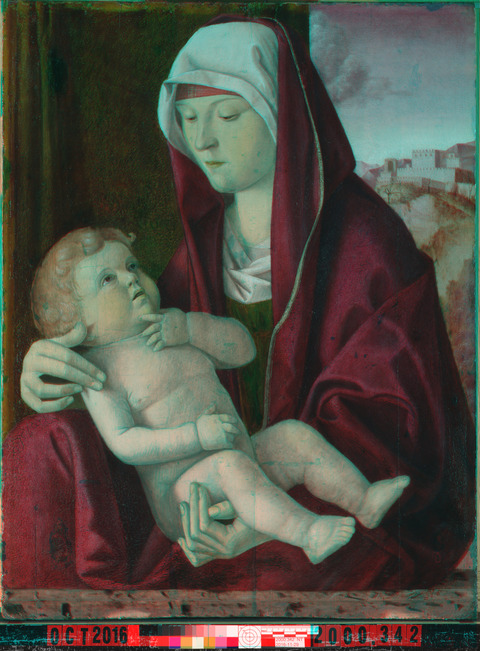
Surface Appearance:
The surface exhibits numerous small losses in the curtain area with many layers of glazing applied over top to compensate for the damage. The sides of the panel were painted at some point in the painting’s past, but this is likely a restoration and was later partially removed. Approximately 7 cm of paint is still present along the upper-right edge.
Condition of Paint
The painting exhibits a craquelure network throughout. Some traction craquelure is present in the blue and red areas due to differences in stresses between the panel, ground, and paint layers. It is possible that there is an instability related to the blue and red pigments. The skin tones appear particularly well preserved. A cracking network is present in the light gray-blue background where the application of paint may have been applied in a thin wash over an oil-rich area. This has caused retraction and cracking, revealing a darker area underneath along with trapped dirt. Abrasion is present along the edges where the painting is in contact with the frame. Significant abrasion is present in the red curtain area along with traction crackle. Glazing was liberally applied in the reds, which are the most damaged component of the composition.
Description of Varnish/Surface Coating
Analyzed Observed Documented
| Type of Varnish | Application |
|---|---|
| Natural resin | Spray applied |
| Synthetic resin/other | Brush applied |
| Multiple Layers observed | Undetermined |
| No coating detected |
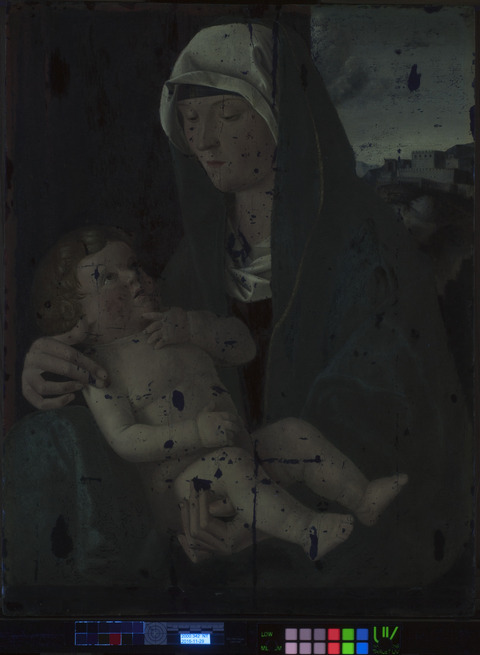
The painting appears to have a synthetic varnish on its surface. The original varnish of the painting is no longer present, as the painting has undergone several restoration campaigns. Retouching can be seen when the painting is viewed under ultraviolet-induced visible fluorescence (tech. fig. 14).
Condition of Varnish/Surface Coating
The varnish is in adequate condition and imparts neither a bright shine nor too dull of an appearance to the paint layer. Several large losses with liberal retouching, some using a linear inpainting technique similar to a traditional tratteggio, are present across the painting (tech. fig. 15). These are visible in the ultraviolet-induced visible fluorescence photograph (tech. fig. 14) and in photomicrographs (tech. figs. 15, 16).
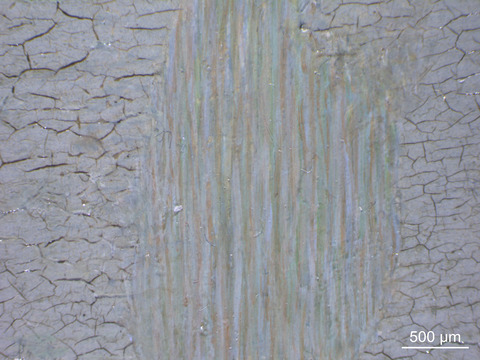
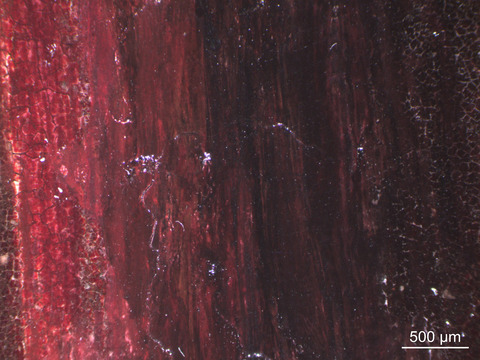
Description of Frame
Original/first frame
Period frame
Authenticity cannot be determined at this time/ further art historical research necessary
Reproduction frame (fabricated in the style of)
Replica frame (copy of an existing period frame)
Modern frame
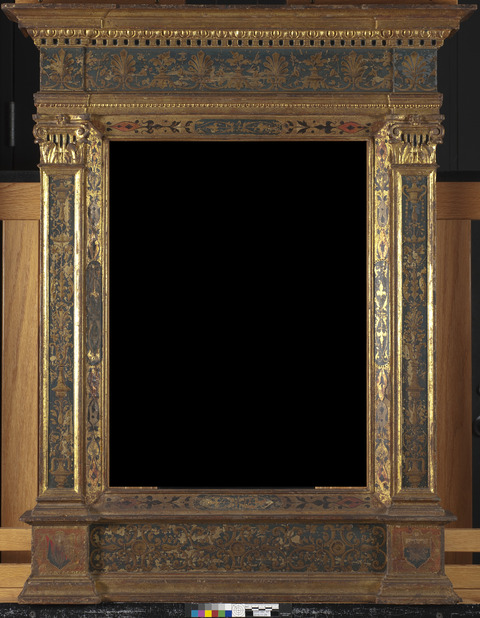
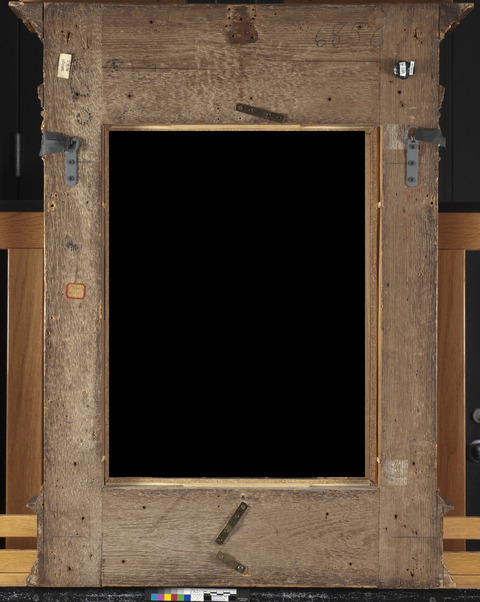
Frame Dimensions:
Outside Frame Dimensions: 70 × 89 × 11.5 cm (widest point)
Sight size: 39.5 × 53 cm
Distinguishing Marks:
Item 1. Black writing on back of frame, top member, right: “6856”
Item 2. Customs stamp on back of frame, top member, left, illegible
Item 3. Customs stamp on back of frame, top member, left, illegible
Item 4. White rectangular label with double red border on back of frame, proper right member: C9401 TSO”
Item 5. Other faded black scribbles on back of frame, throughout, illegible
Description of Molding/Profile:
The frame is water gilded. Sgraffito is present along with an incised pattern. Blue paint is present along the larger frieze areas. Black and red decorative elements line the interior section.
Condition of Frame
General wear is present throughout the frame. Old damages and losses are present in the sgraffito layer.
Notes
-
Paul A.J. Spheeris, “Conservation Report on the Condition of the Clowes Collection,” 25 October 1971, Conservation Department Files, Indianapolis Museum of Art at Newfields. ↩︎
-
Martin Radecki, Clowes Collection condition assessment, undated (after October 1971), Conservation Department Files, Indianapolis Museum of Art at Newfields. ↩︎
-
Intermuseum Conservation Association, “Clowes Collection Conservation Report,” C10005 (2000.342), 8–10 April 1974, Conservation Department Files, Indianapolis Museum of Art at Newfields. ↩︎
-
Memorandum from Carl J. Weinhardt to Martin J. Radecki, “Charges for Conservation of Objects in the Clowes Collection,” 15 February 1974, Conservation Department Files, Indianapolis Museum of Art at Newfields. ↩︎
-
Peter Klein, wood identification report, C10005 (2000.342), 1999, Conservation Department Files, Indianapolis Museum of Art at Newfields. ↩︎
-
Cinzia Maria Mancuso, “Giovanni Bellini and His Workshop: A Technical Study of Materials and Working Methods,” in Giovanni Bellini and the Art of Devotion, ed. Ronda Kasl (Indianapolis: Indianapolis Museum of Art, 2004), 130–31. ↩︎
-
Cinzia Maria Mancuso, “Giovanni Bellini and His Workshop: A Technical Study of Materials and Working Methods,” in Giovanni Bellini and the Art of Devotion, ed. Ronda Kasl (Indianapolis: Indianapolis Museum of Art, 2004), 132. ↩︎
-
Cinzia Maria Mancuso, “Giovanni Bellini and His Workshop: A Technical Study of Materials and Working Methods,” in Giovanni Bellini and the Art of Devotion, ed. Ronda Kasl (Indianapolis: Indianapolis Museum of Art, 2004), 139. ↩︎
-
Elvacite 2040 (synthetic resin) was used to fill the cradle so that its appearance would be minimized in the X-radiograph, allowing the composition to be better interpreted. ↩︎
-
Andrea Golden, “Creating and Re-creating: The Practice of Replications in the Workshop of Giovanni Bellini,” in Giovanni Bellini and the Art of Devotion, ed. Ronda Kasl (Indianapolis: Indianapolis Museum of Art, 2004), 99. ↩︎
-
Jill Dunkerton, “Bellini’s Technique,” in The Cambridge Companion to Giovanni Bellini, ed. Peter Humfrey (Cambridge: Cambridge University Press, 2003), 201. ↩︎
-
Cinzia Maria Mancuso and Antonietta Gallone, “Giovanni Bellini and His Workshop: A Technical Study of Materials and Working Methods,” in Giovanni Bellini and the Art of Devotion, ed. Ronda Kasl (Indianapolis: Indianapolis Museum of Art, 2004), 136, 139–40. ↩︎
-
Cinzia Maria Mancuso and Antonietta Gallone, “Giovanni Bellini and His Workshop: A Technical Study of Materials and Working Methods,” in Giovanni Bellini and the Art of Devotion, ed. Ronda Kasl (Indianapolis: Indianapolis Museum of Art, 2004), 135–36. ↩︎
-
Joyce Plesters, “Ultramarine Blue, Natural and Artificial,” in Artists’ Pigments: A Handbook of Their History and Characteristics, vol. 2, ed. Ashok Roy (New York: Oxford University Press, 1993), 39. ↩︎
-
Bruno Muhlethaler and Jean Thissen, “Smalt,” in Artists’ Pigments: A Handbook of Their History and Characteristics, vol. 2, ed. Ashok Roy (New York: Oxford University Press, 1993), 116. ↩︎
-
Cinzia Maria Mancuso and Antonietta Gallone, “Giovanni Bellini and His Workshop: A Technical Study of Materials and Working Methods,” in Giovanni Bellini and the Art of Devotion, ed. Ronda Kasl (Indianapolis: Indianapolis Museum of Art, 2004), 135. ↩︎
-
Cinzia Maria Mancuso and Antonietta Gallone, “Giovanni Bellini and His Workshop: A Technical Study of Materials and Working Methods,” in Giovanni Bellini and the Art of Devotion, ed. Ronda Kasl (Indianapolis: Indianapolis Museum of Art, 2004), 135, 149 fig. 19. ↩︎
-
Cinzia Maria Mancuso and Antonietta Gallone, “Giovanni Bellini and His Workshop: A Technical Study of Materials and Working Methods,” Giovanni Bellini and the Art of Devotion, ed. Ronda Kasl (Indianapolis: Indianapolis Museum of Art, 2004), 131, 135. ↩︎
Additional Images
